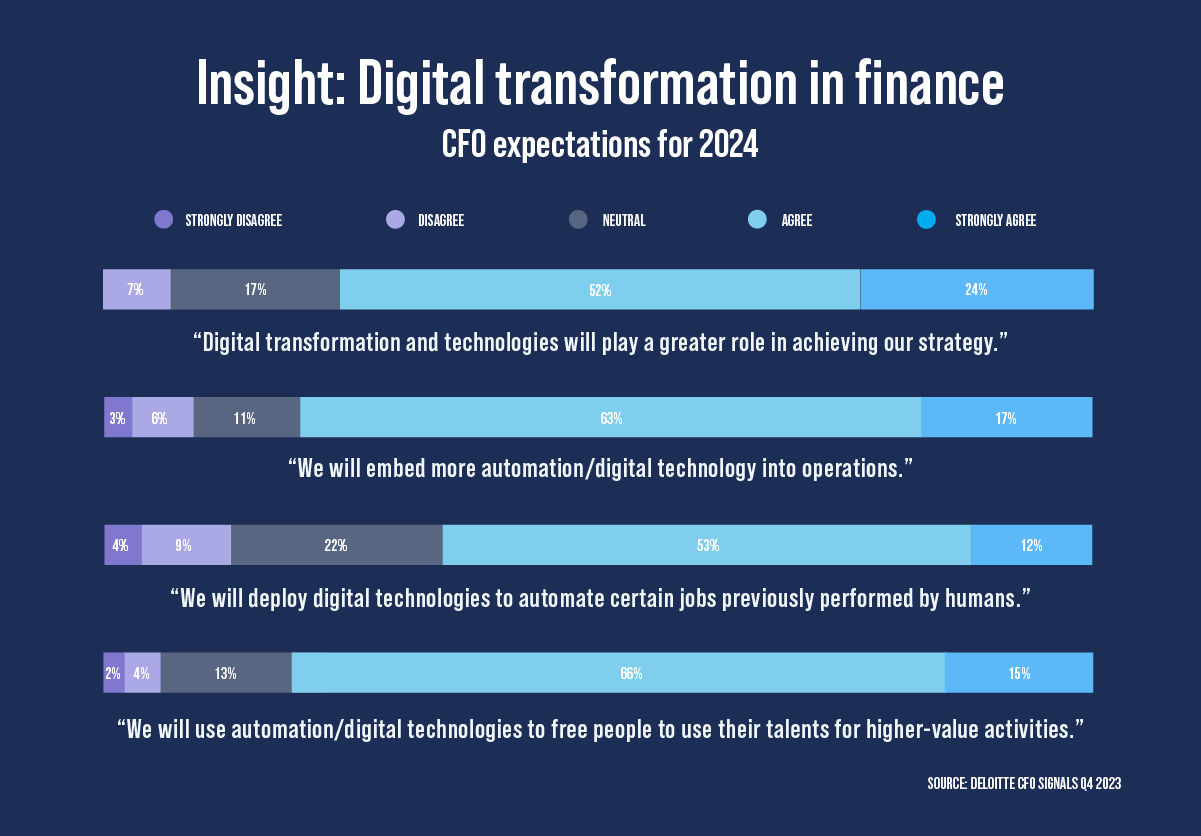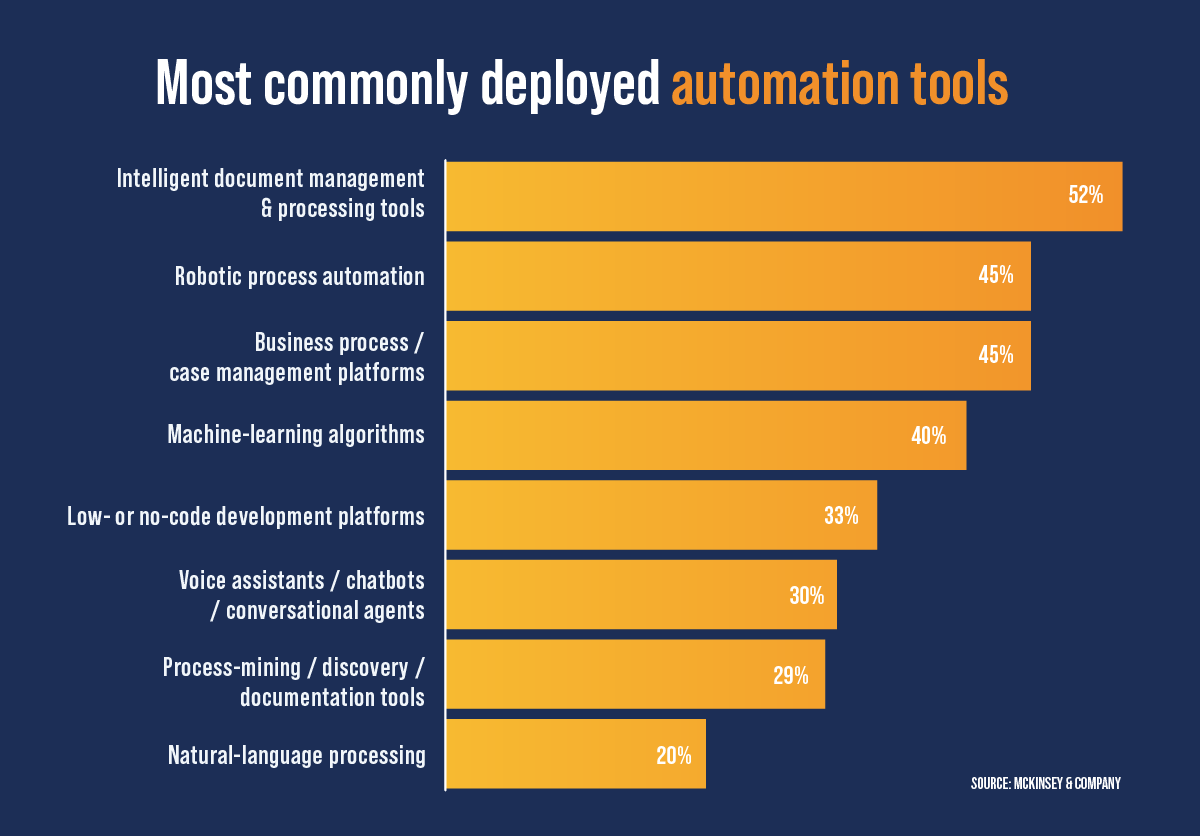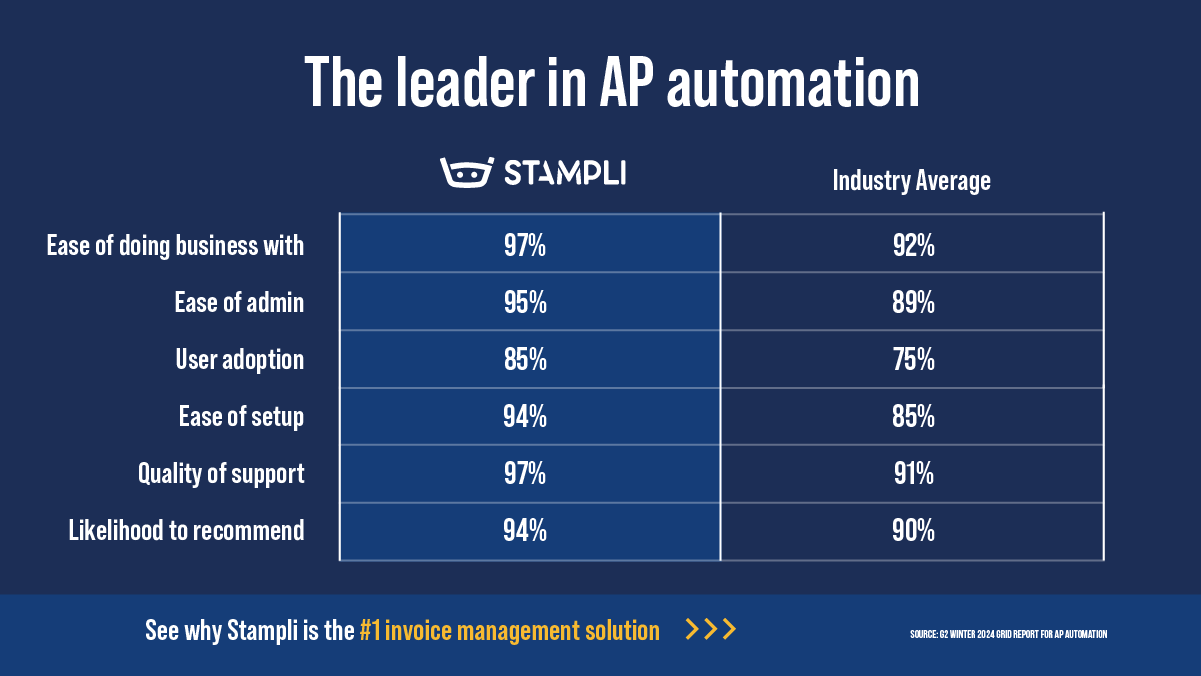What is financial process automation? A strategy guide for finance leaders

In today’s highly competitive business landscape, finance leaders are under pressure to reduce costs, improve financial performance, support revenue growth, and provide strategic direction. Financial process automation (FPA) can help them achieve these goals.
According to PwC’s 2024 Pulse Survey, 58% of CFOs say they’re spending more time on technology investment and implementation than in 2023. Nearly half are prioritizing technology implementation to improve financial department capabilities, and 44% say increasing the use of technology to reduce costs is a top priority for the next 12 months.
FPA uses technology to automate complex and repetitive manual processes like invoice processing, expense approvals, and reporting. By eliminating these slow, error-prone tasks, FPA reduces errors, speeds up accounting processes, and makes finance departments more efficient. It also provides a high level of visibility and control over financial processes, turning financial operations into a powerful strategic driver for the business.
In this article, you’ll learn what finance automation is, how it works, and how it can help you transform your financial operations. We’ll explore the benefits, challenges, technologies, features, and best practices so you can get the most out of FPA for your business.
What is FPA and how does it work?
At a high level, finance process automation covers a broad range of digital solutions and technologies used to automate manual financial processes. FPA solutions can include automation tools to automate specific finance functions like payment processing or complete solutions to streamline finance operations across the organization.

What are the leading finance automation technologies?
FPA technologies are rapidly evolving to become faster, smarter, and more powerful. Here are the 5 leading cloud-based software solutions, hardware systems, and automation technologies businesses use to automate, optimize, and streamline financial processes today.
Cloud-based finance automation software
Financial automation software includes point solutions, accounting software, and other platforms that automate financial processes. Unlike traditional on-premise solutions, Cloud-based FPA solutions are scalable, accessible, and easy to implement. They can be accessed from anywhere using various devices, making it easier for finance teams to work and collaborate remotely.
Artificial Intelligence (AI) and machine learning (ML) solutions
Advanced FPA solutions like Stampli leverage AI and ML technologies to handle complex tasks that require decision-making, anomaly detection, pattern recognition, and learning. These systems learn from past actions to improve their performance and adapt to the company’s existing processes. For example, as Billy the Bot, Stampli’s AI assistant, processes invoices, it learns the company’s cost accounting rules and AP processes, and applies the appropriate GL codes and approval routing to each invoice.
Optical character recognition (OCR) document capture
OCR technology extracts data from scanned and digital documents and images, eliminating the need for manual data entry. It can be used to digitize invoice details, contacts, purchase orders, and other documents. OCR streamlines document processing and reduces data entry errors.
Enterprise resource planning (ERP) systems
ERPs integrate business functions like accounting, inventory management, purchasing, expense management, and financial reporting into a single automated finance platform. They streamline business processes by eliminating manual tasks and automatically sharing data across the organization. Large ERPs like Sage Intacct and SAP offer optional modules to automate specific processes like payroll management. Companies can also use third-party ERP integrations to add advanced functionality, such as three-way invoice matching, beyond the basic features offered by the ERP.
Robotic process automation (RPA)
RPA automates high-volume, repetitive manual tasks by mimicking human actions. Businesses can program RPA bots to interact with financial automation software and ERPs to automate functions like data entry and account reconciliation.
Top 5 benefits of finance process automation
Companies that leverage automation in finance realize significant benefits. Here are the top five benefits of automation reported by finance leaders.
1. Improved accuracy
Errors can cause financial and reputational damage to your business. FPA reduces human error by replacing manual tasks like data entry and reconciliations. It also ensures data integrity and consistency by automatically syncing data between ERPs and other business systems.
2. Cost savings and increased employee productivity
FPA eliminates repetitive tasks and significantly reduces labor costs. These savings can be directly reinvested to fuel growth initiatives. Automated processes and improved productivity also free finance teams to focus on strategic, high-value activities and enable your business to scale efficiently without the need for additional headcount.
3. Greater visibility and enhanced decision-making
By providing accurate, real-time financial data, analyses, and reports, FPA enables finance leaders to make informed, strategic decisions. For example, AP automation platforms let AP teams monitor invoice and payment status. Using these insights, they can anticipate supplier payments and take a proactive approach to cash flow management.
4. Smarter and faster approval routing
Approvals and reviews can cause a bottleneck in financial processes. Some FPA solutions feature customizable finance workflows that can be used to automate approval routing. Finance teams can set up rules that route invoices to the appropriate approver based on transaction value, department, or other criteria.
5. Improved internal controls and regulatory compliance
FPA solutions mitigate the risk of errors and fraud by automatically enforcing internal controls like separation of duties. They also track and record user actions and communications to provide a complete audit trail. These features ensure accurate financial reporting and help companies remain compliant with tax obligations and regulatory requirements.
Top finance processes to be automated
Virtually any financial process can be automated. However, it’s best to start with those with the highest return on investment. Here are the top functions you can automate to save money, improve efficiency, and gain visibility and control over your financial processes.

Payroll
For most companies, payroll is the largest expenditure and generally the first financial process to be automated. You can automate payroll functions such as:
- Calculating employee salaries, bonuses, income tax, deductions, overtime, and commissions.
- Automating pay schedules and paycheck deposits.
- Managing employee information.
By automating these functions, companies can reduce manual payroll tasks, cut costs, and ensure employees are paid accurately and on time.
Accounts payable
After payroll, accounts payable is usually the second-largest expenditure for most businesses. AP spend itself comes in many different forms and across departments, but far too often AP is processed and reconciled manually. AP functions that can be automated include:
- Invoice scanning, data entry, coding, and verification.
- Automated purchase order matching.
- Approval routing and vendor payment processing.
- Invoice status and AP performance reporting and analytics.
Automating accounts payable gives businesses visibility and control over AP processes, reduces errors and missed payments, and improves invoice processing efficiency.
Accounts receivable
Accounts receivable automation eliminates the manual tasks of invoicing customers and collecting payments. AR roles that businesses can automate include:
- Generating and sending customer invoices.
- Processing customer payments.
- Capturing and entering data into the AR ledger and producing reports.
Automating accounts receivable helps businesses get paid faster, ensuring healthy cash flow and helping to maximize profits. For small businesses, financial automation solutions that combine AR and AP features, such as BILL, can be adequate. However, as business grow and their financial processes become more complex, they will find that combined solutions have limitations. They will need specialized AR and AP tools that provide enhanced functionality and scalability.
Expense management
Expense management automation streamlines cumbersome manual employee expense reporting and reimbursement processes, addressing pain points like inaccurate reports, lost receipts, slow reimbursement, and limited visibility into spending.
- Employee expense reporting and automatic receipt scanning and uploading.
- Expense report approvals and reimbursements.
- Virtual credit cards restrict spend by department, category, or employee.
By automating expense management, businesses can control employee expenditures, prevent fraud, and quickly reimburse employees. However, despite their advantages, many expense management platforms rely on employees making out-of-pocket expenses and then being reimbursed through payroll.
Virtual card solutions like Stampli Card expense cards that are integrated into your AP system. These cards eliminate out-of-pocket expenses and reimbursements. They enable AP to set spending limits, restrict spending to specific vendors, and automatically deactivate cards if there’s evidence of fraud. They also streamline expense reporting — employees can easily upload receipts using their mobile devices to confirm expenses.
Financial close
FPA solutions can help you close your books faster. Here are some of the financial close features they offer:
- Automated reconciliation of bank statements with AP, revenue, and general ledger records and removal of duplicate records.
- Journal entry creation and report generation.
- Generating financial statements like the balance sheet, profit and loss statement, and cash flow statement.
Automating financial close tasks reduces the time to complete month-end and year-end close and ensures accurate record-keeping and reporting.
Regulatory compliance
Companies can use FPA technologies to comply with tax and regulatory requirements. Here are some of the ways FPA can automate compliance tasks:
- Automating tax calculations and reporting.
- Enforcing internal controls, access restrictions, and user roles.
- Maintaining a complete audit trail.
FPA ensures adherence to financial regulations, minimizing the risk of errors and regulatory penalties.
Reporting and analysis
FPA solutions help finance teams monitor financial transactions and track key performance indicators and metrics. These are some of the reporting and analysis tools they offer:
- Real-time reporting of cash flow, liquidity, working capital, cash balances, and other financial metrics.
- Forecasting and scenario modeling for budgeting, cash flow management, and financial planning.
- Presenting clear and understandable metrics and analytics in visual dashboards.
By providing accurate, real-time data and analytics, FPA solutions enable finance teams to make informed decisions.
How to choose the right FPA solution
Choosing the right FPA solution for your business can be difficult. With so many solutions on the market, it can be difficult to know where to start. In this section, we’ll simplify the process by offering a high-level guide to identifying the FPA solution that meets your needs. We’ll explore the success factors that differentiate leading FPA platforms and explain how to overcome common implementation challenges.
Assess your current financial automation needs
Start by assessing your current financial processes to find the best automation candidates. Identify pain points, bottlenecks, workarounds, and areas where automating manual workflows will have the biggest impact. For example, look for areas like invoice management or employee expense reporting where your business may still be relying on manual paper-based processes that can be automated.
Research potential FPA solutions
Once you’ve identified and prioritized the areas for improvement, research the FPA solutions and providers to find the best fit for your business. Consider your budget, current and future needs, and each provider’s track record and customer support.
Leading FPA solutions excel in these key areas:
Seamless ERP integration
Most FPA solutions offer integration with ERPs and accounting software but only provide limited file-based integrations. The best FPA solutions offer seamless API integrations to enable real-time data sharing and collaboration. Stampli’s pre-built integrations support ERPs’ native functionality and can be implemented in days, not months, with no changes to existing processes.
According to one reviewer: “One of the standout features of Stampli is its seamless integration with existing accounting systems. Regardless of whether your organization utilizes QuickBooks, NetSuite, or another platform, Stampli seamlessly integrates, eliminating the need for tedious manual data entry and ensuring data accuracy.”

AI-powered processing and analytics
Many FPA solutions offer basic financial automation features that lack the power and flexibility to fully automate financial processes. AI-powered FPA solutions go beyond automating financial processes with advanced features such as intelligent document processing, adaptive dynamic workflows, and anomaly detection. Billy the Bot, Stampli’s AI assistant, serves as an AP copilot — it learns the patterns in your company’s cost accounting and approval processes, including edge cases and tribal knowledge.
“Using this resource has provided us with several advantages,” says one Stampli customer. “To begin with, it has streamlined and automated the invoice management process, which has cut down on the effort and resources needed for invoice management that was previously done manually.
“Second, it allowed for better monitoring and control of cash flow, leading to better financial decision-making.
“Finally, the platform’s cutting-edge capabilities, such as automatically detecting and fixing invoice problems, have increased the company’s productivity.”
Intuitive and user-friendly interface
Certain FPA solutions, despite their powerful automation features, are hampered by complicated, rigid user interfaces. This forces finance employees to navigate through multiple complex menus and documents to get their work done. In contrast, leading FPA solutions offer simple, easy-to-understand interfaces that are designed to help finance teams rather than hinder their progress.
“What I appreciate most about Stampli is its intuitive interface and seamless integration into our accounts payable workflow,” commented one reviewer. “It has significantly simplified the submission and approval of invoices, eliminating many of the cumbersome steps that used to slow us down. The platform’s efficiency in handling invoices has not only saved us a considerable amount of time but also reduced the potential for errors.
“Its ease of use stands out; Stampli has made it possible for our team to manage our invoicing process more effectively, allowing us to allocate our time to other critical tasks. The impact on our productivity has been remarkable, making Stampli an invaluable tool in our AP processes.”
Human in the loop
According to the survey “Artificial Intelligence in Accounts Payable 2023” by Stampli and Probolsky Research, most (89%) finance leaders said they wanted to implement AI solutions in their organizations. However, the survey also revealed concerns regarding the lack of human oversight in AI decision-making. A sizable group (32%) of leaders and an even larger percentage (68%) of AP employees said this concern made them reluctant to deploy AI in their financial operations.
Leading AI-powered finance processing automation solutions ensure human oversight of AI decisions. They “keep a human in the loop” by clearly indicating when and where the AI is making a suggestion and requiring human review before accepting the suggestion.
“The AI assistant filling out some of the fields makes processing faster for me,” commented a Stampli customer. “I can focus on double-checking information instead of having to key out everything by hand, which makes my process a lot smoother. The user interface is also very easy to get used to, so the transition into using Stampli was very easy for me…Stampli lets me process invoices and export them to our financial system faster than before.”
Positive onboarding experience and customer support
Implementing FPA can result in changes to existing workflows. Employees may resist these changes out of fear of job displacement or discomfort with new technologies. A well-planned change management strategy with clear communication, training, and support can help address employees’ concerns and facilitate a smooth transition.
“I am the Director of Workforce Management with a Healthcare Group, my review is based on invoice tracking, approval, and team collaboration from all levels,” says one Stampli customer. “Since signing on with Stampli, invoices have a clear streamline of heirarchy and organization! The onboarding process was a breeze and the system is extremely user-friendly. I was hesitant about bringing my team on board as we have multiple hands approving and reviewing our invoices, but Stampli has exceeded the expectations and process. My team is on stampli every day and we can collaborate so easily on one invoice all in one place.”
Implementation and onboarding plan
After you’ve selected an FPA tool, you’ll need to implement it in your organization and bring your finance team on board. Successful FPA implementation requires careful planning and coordination. Involve stakeholders early in the process to ensure they’re on board with the implementation plan.
Stampli is recognized as the industry leader in customer satisfaction for AP automation solutions. It consistently scores above average in customer reviews for ease of use, implementation, and user adoption.

As the only financial automation platform designed by AP professionals for AP professionals, Stampli is the ideal choice for a fast and easy-to-implement solution that brings efficiencies to your existing processes.
“You can tell that Stampli has been designed and improved by AP professionals. Every time you think ’it would be really nice if…’ Stampli probably addresses that.” commented one customer.
“The time savings are huge. Our job engagement improved (data entry is a bore). Our invoice approval process has been brought to the next level,and has been standardized. All of our non-Accounting staff that needs to interact with Stampli raves about it…
“For a ’can’t deny it’ data point: in our 2nd week on Stampli, we processed more invoices than we ever had in a week, and had the lowest number of invoices pending approval since we’ve tracked that stat.”
Stampli: A strategic investment in financial process automation
Financial process automation done right delivers success.
Expectations for finance leaders are getting tougher. You need the tools and insights to deliver results and transform your finance team into a powerful strategic driver.
Invest in the right solution and partner for effective financial workflow automation. Stampli will support your team before and after implementation. Our experts will offer insights into how your organization might get the most out of your AP automation solution.
Get strategic about financial management today! Contact one of Stampli’s experts for a free demo.